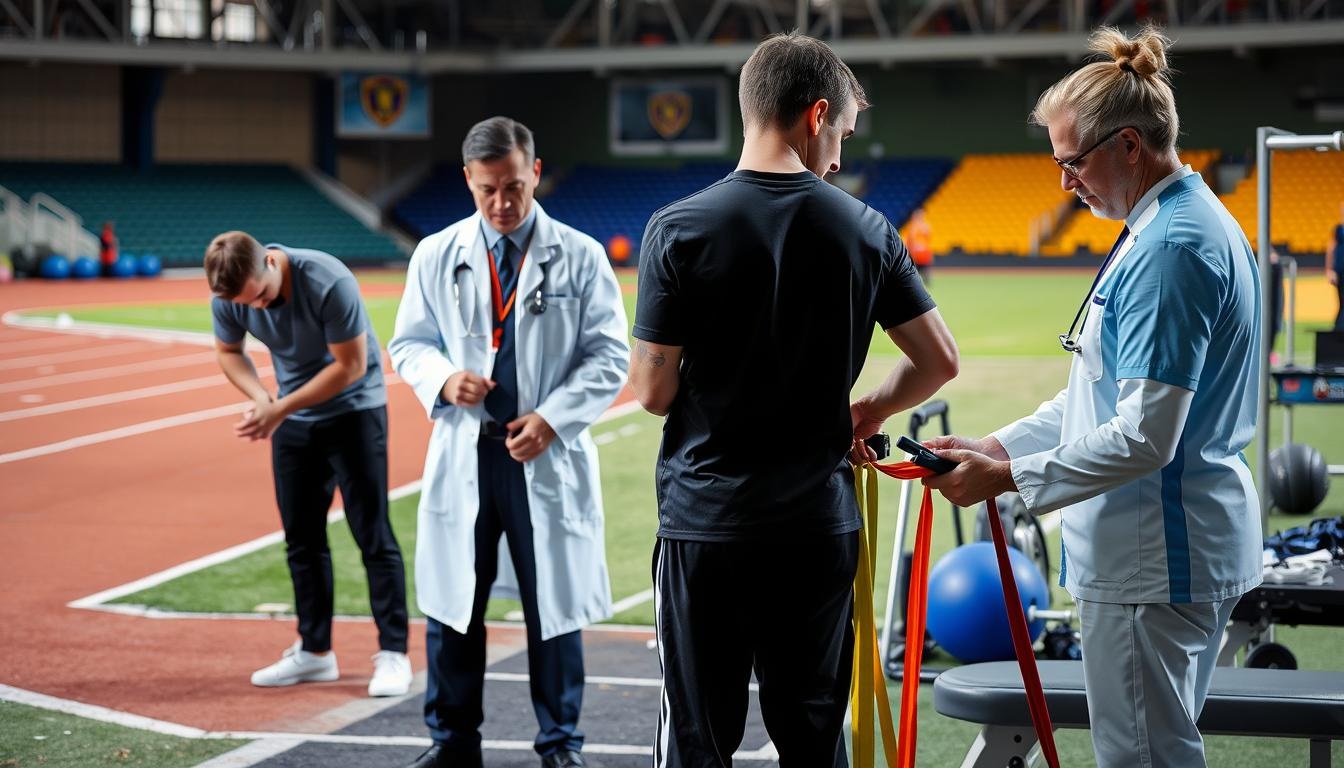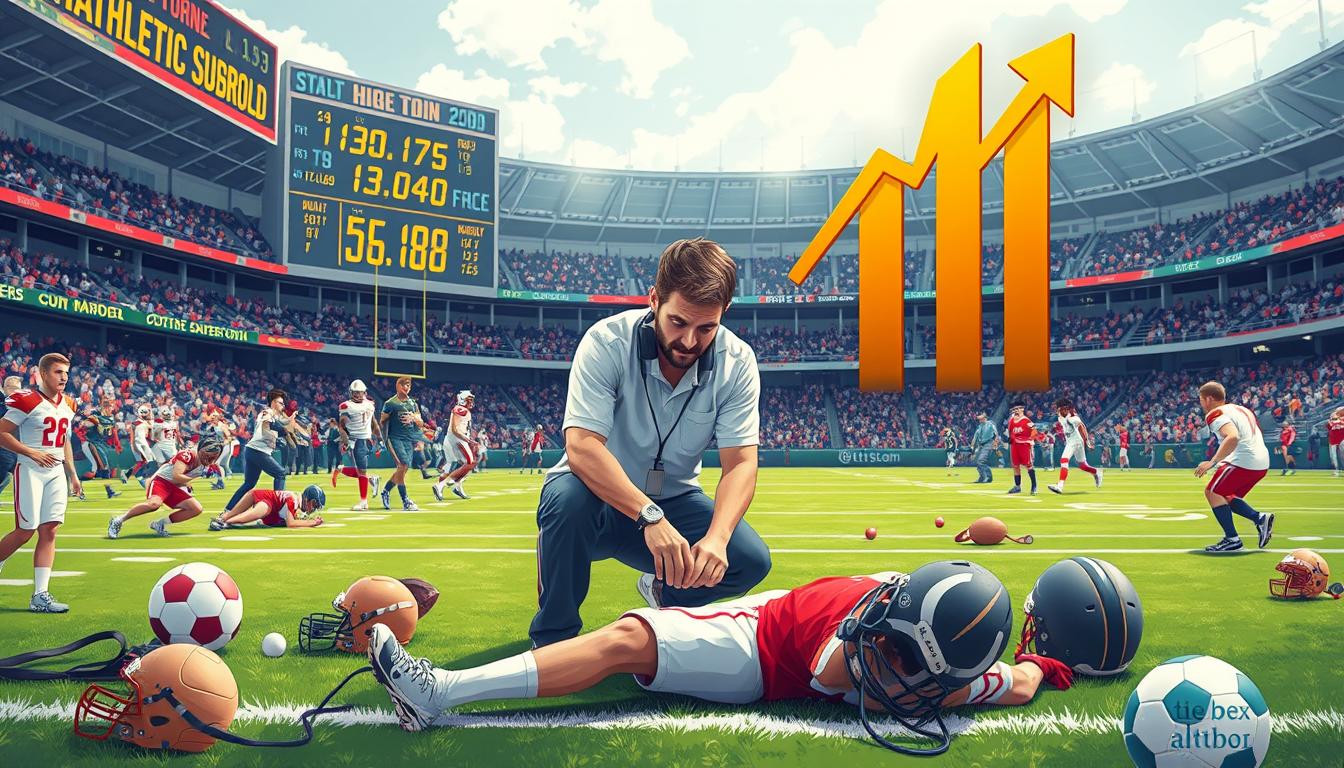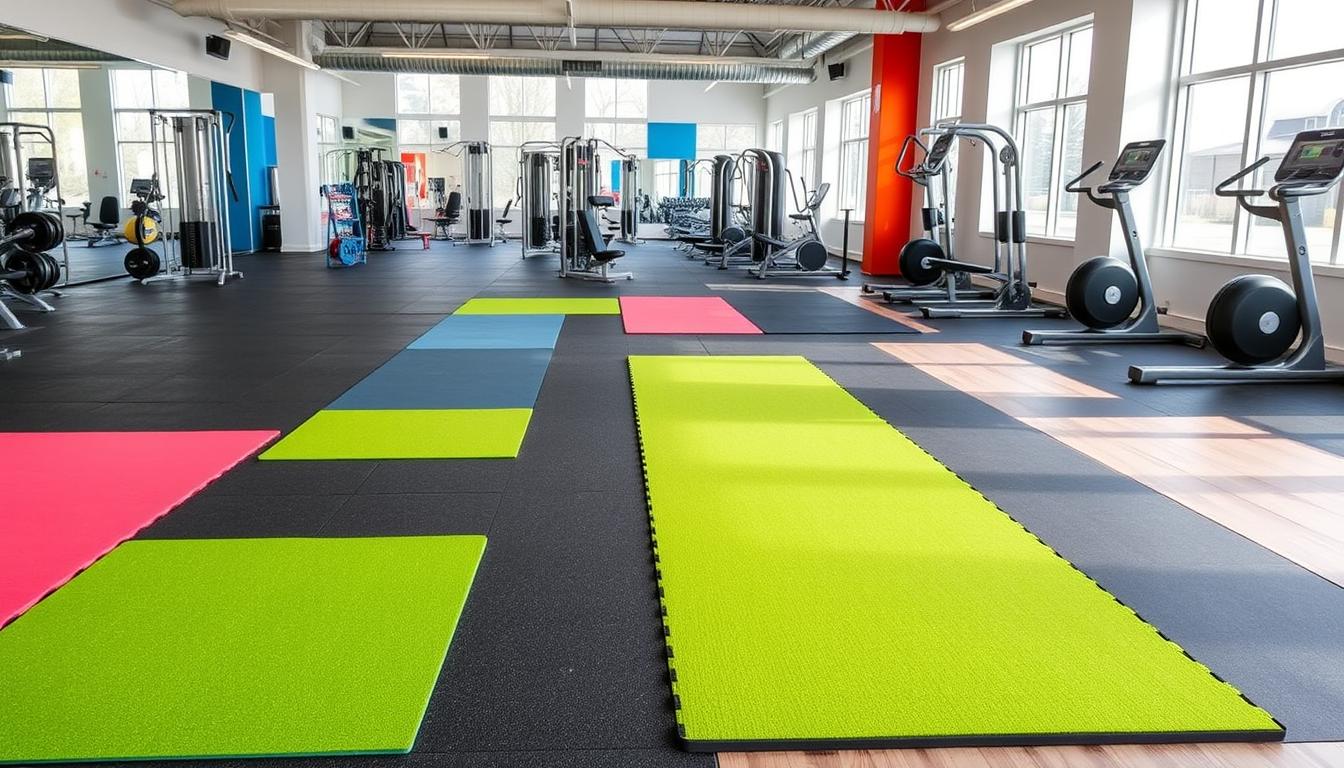Imagine a world where every athlete, from the casual player to the top pro, has access to healthcare pros focused on their health. This is the world of the athletic trainer, a key player in sports medicine. As you start your journey, let me share my own story and the big impact these heroes have on athletes.
I was always into sports, always trying to do my best. But it was the athletic trainer who helped me the most. They gave me the care and advice I needed to get over injuries and come back stronger. Their knowledge in preventing, diagnosing, and treating injuries was crucial, and I saw how their hard work and love for their job changed athletes’ lives.
Now, the sports medicine field is set for big growth. The U.S. Bureau of Labor Statistics says there will be a 17% increase in athletic training jobs from 2021 to 2031. This increase shows how important athletic trainers are in keeping athletes healthy, improving their performance, and enhancing their overall well-being.
If you’re an athlete, a healthcare fan, or looking for a rewarding career in sports medicine, the path of the athletic trainer is open to you. Let’s explore the exciting opportunities ahead. Find out how you can make a difference in athletic training compensation and sports therapy income.
Table of Contents
Understanding the Role of an Athletic Trainer
Athletic trainers are key in sports medicine. They handle the first steps in treating sports injuries. In the U.S., they earn about $48,420 a year. They work hard to keep athletes healthy and performing well.
Key Responsibilities of an Athletic Trainer
Check on athletes, find out what’s wrong, and create treatment plans. They work with doctors, coaches, and athletes to help them get better. Their main jobs include:
- Providing emergency care and first aid for injuries sustained during sporting events
- Evaluating the extent of injuries and assessing the need for further medical attention
- Designing and implementing rehabilitation programs to help athletes recover from injuries
- Educating athletes on injury prevention techniques and strategies to maintain overall physical fitness
Differences Between Athletic Trainers and Other Professionals
Are different from other healthcare workers. They have special skills for sports injuries. They are often on the field, ready to help athletes right away.
They also focus on the whole athlete, not just the injury. They care about the athlete’s mind and feelings too. This makes them unique in sports medicine.

Education and Certification Requirements
To become an athletic trainer, you need to meet strict education and certification standards. First, you must earn a master’s degree from a program accredited by the Commission on Accreditation of Athletic Training Education (CAATE). These programs teach you about anatomy, physiology, sports medicine, and more. They also include clinical rotations to help you develop key skills.
After getting your degree, you must pass the Board of Certification (BOC) exam to become a certified athletic trainer (ATC®). This exam shows you know how to prevent injuries, assess them, and provide emergency care and rehabilitation. Most states also require athletic trainers to get a license. This means you’ll need to keep learning to keep your license.
Degree Programs for Aspiring Athletic Trainers
While a bachelor’s degree in exercise science or sports medicine is a good start, most athletic trainers get a master’s degree. These programs go deeper into sports medicine, injury management, and rehabilitation. They prepare you to succeed in this fast-paced field.
- Bachelor’s degree programs teach you about anatomy, physiology, biomechanics, and nutrition.
- Many universities offer “3+2” programs. These let you get a bachelor’s and master’s degree in five years.
- Getting hands-on experience through clinical experiences and internships is key.
Certification and Licensing Guidelines
Passing the BOC exam is a big step for aspiring athletic trainers. It tests your skills in injury prevention, emergency care, and more. After becoming certified, you must keep your skills sharp by taking continuing education courses.
Also, most states require athletic trainers to have a license. These rules make sure everyone meets high standards in sports rehabilitation and athletic training compensation. It’s important to stay up-to-date with new developments in the field to do well in your career.
Essential Skills for Athletic Trainers
You are key in sports medicine. You do more than just treat injuries. You are part of the healthcare team, giving athletes full care and helping prevent injuries. To do well, you need both technical skills and soft skills.
Communication Skills in Sports Medicine
Good communication is crucial for you. You must explain medical info clearly to athletes, coaches, and other health pros. Your ability to work well with others helps the whole team. This ensures athletes get the best care.
Physical Fitness and Injury Assessment Techniques
Your fitness and injury skills are very important. You need to spot and fix many sports injuries. Keeping up with new ways to assess and treat injuries is key. This helps athletes get back to sports safely and quickly.
| Essential Skills | Description |
|---|---|
| Communication | Ability to effectively convey medical information to athletes, coaches, and healthcare professionals |
| Physical Fitness | Maintaining a high level of physical conditioning to perform job duties |
| Injury Assessment | Proficiency in evaluating and diagnosing a wide range of sports-related injuries |
| Critical Thinking | Ability to make informed decisions and problem-solve in a dynamic environment |
| Compassion | Empathy and understanding when working with injured athletes |
| Professionalism | Maintaining the highest standards of ethics, confidentiality, and patient care |
| Time Management | Effectively prioritizing tasks and managing a busy schedule |
By getting good at these skills, you can be a top athletic trainer. You’ll make a big difference in sports medicine careers.

The Importance of Athletic Trainers in Sports
Are key in sports, protecting athlete health and safety. They prevent, diagnose, and treat injuries. They work in hospitals, clinics, the armed forces, and public safety.
Injury Prevention Strategies
Use injury prevention strategies to lower injury risks. They check athletes’ biomechanics, strength, and flexibility. This helps them create custom conditioning programs.
These programs keep athletes in top shape. It reduces injury chances during games and practices.
Emergency Response Protocols
When injuries happen, act fast. They know how to handle sports injuries. They give first aid and start emergency plans.
This quick action is crucial. It helps athletes get the best care right away.
Are essential for athlete health. They work with coaches and doctors for athlete care. This creates a safe environment for everyone.

“Having an athletic trainer on staff provides peace of mind for parents and coaches, ensuring athletes receive appropriate care and legal protection for sports programs.”
Are vital for athlete safety. They prevent injuries and respond to emergencies. Their skills and commitment are priceless to sports programs.
Career Opportunities in Athletic Training
Are you interested in becoming an athletic trainer? You’ll find many career paths in sports medicine. Athletic trainers help keep athletes and active people healthy.
Settings Where Athletic Trainers Work
Athletic trainers work in many places. Here are some examples:
- Educational institutions (schools, colleges, and universities)
- Rehabilitative offices and sports medicine clinics
- Professional and collegiate sports teams
- Military branches and law enforcement agencies
- Hospitals and healthcare facilities
- Fitness centers and gyms
- Performing arts organizations (e.g., dance companies, theaters)
The biggest employers are schools. There, trainers help student-athletes avoid and treat injuries.
Specializations Within Athletic Training
You can specialize in certain areas. Here are a few:
- Sports-specific focus (e.g., football, basketball, gymnastics)
- Age-group specialization (e.g., pediatric, collegiate, or geriatric populations)
- Injury-specific expertise (e.g., concussion management, orthopedic rehabilitation)
- Performance enhancement and sports psychology
Specializing can make you more valuable. It lets you focus on what you’re best at.
| Factors | Athletic Trainer Pay | Sports Medicine Salary |
|---|---|---|
| Annual Salary Range | $50,000 to $80,000 | Varies widely based on specialty and experience |
| Job Growth Outlook | Projected 13% growth from 2023 to 2033 | Estimated 13% growth for athletic trainers, varying for other sports medicine professions |
| Education Requirements | Master’s degree in athletic training | Varies by role, from bachelor’s to doctoral degrees |
| Certification and Licensing | Certified Athletic Trainer (ATC) credential | Dependent on specific sports medicine specialty |

Looking into sports medicine? Check out the sports medicine salary and athletic trainer pay. Also, consider job growth and education needs. With the right skills and effort, you can have a fulfilling career helping athletes and active people.
Salary Expectations and Job Outlook
Athletic trainers are key in sports medicine and rehabilitation. They care for athletes and help with wellness. What salary can you expect, and what’s the job outlook? Let’s look at what affects athletic training pay and the job’s future.
Average Salary for Athletic Trainers
The U.S. Bureau of Labor Statistics says athletic trainers earn a median of $57,930 a year. But pay can change based on where you work, your experience, and your location. Those in places like California, New York, and Texas might earn more. Newcomers might start with lower pay.
Factors Influencing Earning Potential
- Education level: Those with a master’s degree or special certifications can often get higher pay.
- Years of experience: More experienced trainers, especially those in charge, earn more.
- Industry: Trainers in professional sports or big healthcare systems might get paid more.
- Geographic location: The cost of living in your area can affect your salary.
| Industry | Median Annual Salary |
|---|---|
| Educational services | $59,890 |
| Hospitals | $57,390 |
| Fitness and recreational sports centers | $53,820 |
| Offices of physical, occupational and speech therapists | $53,120 |
Many athletic trainers find their job very rewarding. They enjoy the work, the variety of settings, and chances for growth.
“Athletic training is an incredibly fulfilling career that allows me to make a positive impact on the lives of athletes and active individuals. The job market is strong, and the earning potential is quite good, especially for those who continuously expand their skills and expertise.”
The job outlook for athletic trainers is very good, with a 14% growth rate from 2022 to 2032. This shows a bright future for those in this field.

Continuing Education and Professional Development
As an athletic trainer, it’s key to keep up with sports medicine’s latest. The Board of Certification (BOC) makes sure you do this by needing ongoing education credits. By going to workshops, conferences, and seminars, you learn new things and improve your skills.
Importance of Staying Current in the Field
The field of athletic training is always changing. It’s vital for you to stay updated. Continuing education helps you grow in your career and give top-notch sports medicine services.
Opportunities for Workshops and Conferences
- Go to workshops and seminars by groups like the National Athletic Trainers’ Association (NATA) to learn new sports medicine info.
- Join regional, national, and international conferences to meet other athletic trainers and experts.
- Check out online courses, webinars, and virtual learning to learn more from home or office.
- Take part in events where you can meet other trainers and share ideas.
By always looking for ways to learn more, you can boost your athletic trainer income. You also help the sports therapy field grow and get better.

“Continuing education is the key to maintaining excellence in the field of athletic training. It allows us to stay informed, hone our skills, and provide the best possible care for our athletes.”
Networking and Building Professional Relationships
Getting ahead in sports medicine careers is not just about skills and qualifications. It’s also about networking and building professional relationships. Connecting with healthcare professionals opens doors to collaboration and career growth.
Connecting with Other Healthcare Professionals
It’s crucial to build relationships with team physicians, physical therapists, and strength coaches. These professionals often work with athletic trainers. Strong connections can lead to referrals, joint projects, and job opportunities.
Attend industry events, ask for informational interviews, and engage with peers. This will help you build a strong professional network.
Joining Professional Organizations
- Join the National Athletic Trainers’ Association (NATA), the top organization for athletic trainers. NATA offers resources, networking events, and job listings in sports medicine careers.
- Look into joining the National Strength and Conditioning Association (NSCA) or the American College of Sports Medicine (ACSM). These groups provide education, research, and networking chances.
- Get involved in NATA, NSCA, or ACSM events. Volunteer, join committees, or take on leadership roles. This shows your dedication and expands your network.
Networking and building real professional relationships are key in sports medicine careers. By engaging with others and using professional organizations, you can find new opportunities. This can help increase your trainer wages and career success.

“The people you meet and the relationships you build in this industry can open doors you never knew existed. Networking is a game-changer for athletic trainers looking to advance their careers.” – Coach Nick Nurse, NBA Championship-Winning Coach
Advancing Your Athletic Training Career
Being an athletic trainer is just the start. You can grow your skills and take on new roles. You might want to get more education, specialize, or move into management or teaching. There are many ways to move forward in your career.
Options for Further Education and Specialization
Want to learn more? A Doctorate in Athletic Training (DAT) program could be right for you. Indiana State University has the first DAT program in the country. It focuses on skills like leadership and research.
This program prepares you for big roles in sports medicine. You could lead teams, work in organizations, or teach at a university.
Leadership Roles in Athletic Training
As you get more experience, you might want to lead. You could become a director of a training department. Or, you might move into healthcare or teaching.
Keep learning and stay current with trends. Good leadership skills are essential. This way, you can make a big difference in the lives of athletes and communities.














Leave a Reply